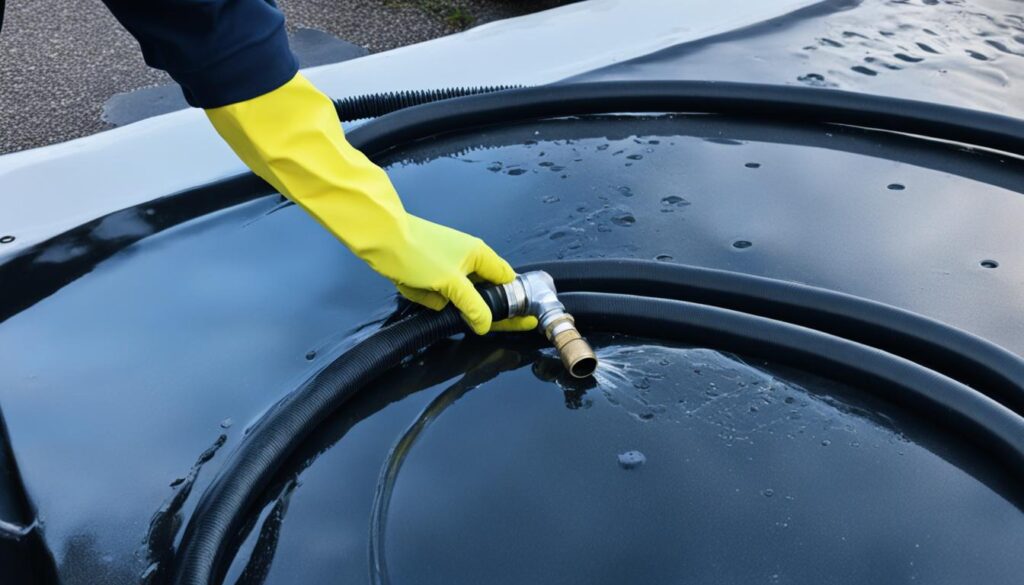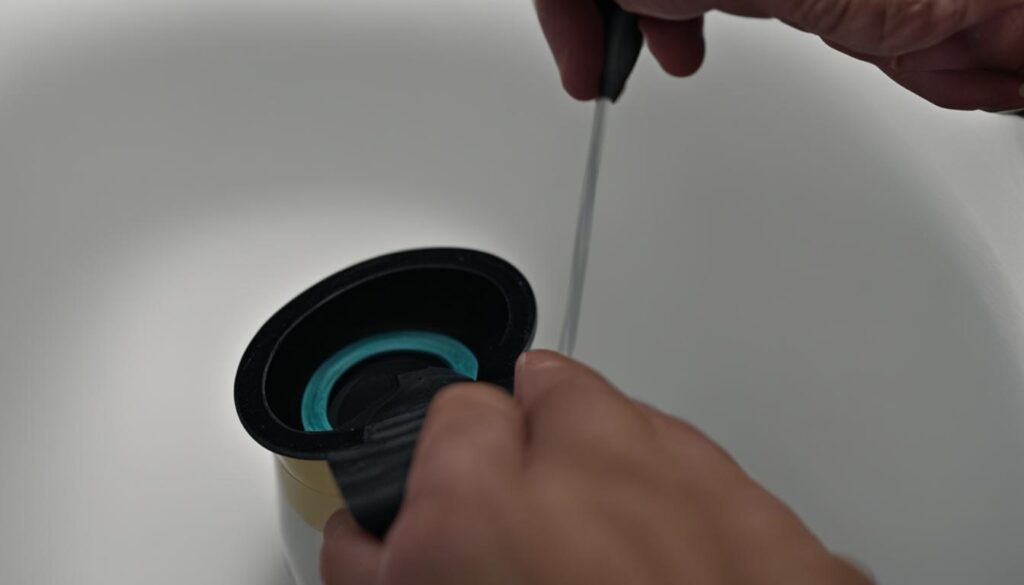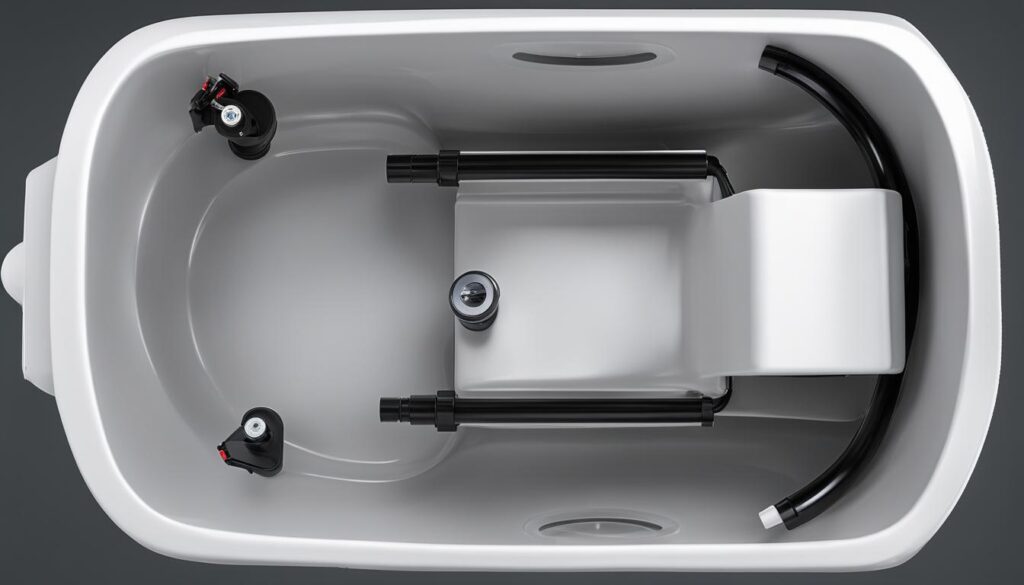Have you ever wondered what happens when you flush the toilet in an RV? How does it differ from a traditional toilet in a house? Well, the answer lies in the mysterious and often misunderstood black tank. Let’s unravel the secrets of an RV toilet system and explore how waste management works in the world of RVing.
Unlike your home toilet, which is connected to the main drain system, an RV toilet empties directly into a black water tank. This black tank is a holding container attached to the underbelly of your RV, designed to collect and store all the waste from your toilet. Understanding how it works and how to properly maintain it is crucial for a pleasant and odor-free RVing experience.
Key Takeaways:
- An RV toilet is connected to a black tank, a holding container for waste.
- Proper maintenance of the black tank and RV toilet is important to prevent odors and clogs.
- RV toilets come in different types, including plastic, porcelain, cassette, and composting toilets.
- Maintaining the black water tank involves regular emptying, using tank chemicals, and winterizing.
- RV toilet seals should be lubricated and inspected for any signs of damage.
Contents
Types of RV Toilets
When it comes to RV toilets, there are several types available to meet the unique needs and preferences of RVers. Let’s explore the different types of RV toilets:
1. Plastic RV Toilets
Plastic RV toilets are a popular choice among RV owners due to their affordability and durability. These toilets are made of lightweight plastic materials, making them easy to install and maintain. They are designed to connect to the RV’s water supply and typically feature a foot pedal for flushing. Plastic RV toilets are suitable for most RV models and provide reliable performance.
2. Porcelain RV Toilets
For RVers seeking a more luxurious experience, porcelain RV toilets are an excellent option. These toilets are crafted from high-quality porcelain, offering a sleek and stylish appearance. Porcelain RV toilets provide enhanced comfort and are known for their durability and longevity. They are a common choice in upscale RVs and motorhomes.
3. Cassette Toilets
Cassette toilets are commonly found in tent trailers and teardrop RVs. These toilets feature a built-in reservoir for fresh water and a compact cassette for waste. Cassette toilets are convenient for RVers who prefer a portable or self-contained toilet system. They are easy to use and maintain, making them suitable for smaller RVs and camping adventures.
4. Composting Toilets
Composting toilets are a sustainable option for RVers who enjoy boondocking or off-grid camping. These toilets use natural processes to break down waste into compost. Composting toilets require minimal water and electricity, making them eco-friendly and cost-effective. While composting toilets may require a bit more maintenance, they offer the freedom of not needing a black water tank. They are a popular choice for environmentally conscious RVers.
Understanding the different types of RV toilets allows you to choose the one that best suits your RVing lifestyle. Whether you opt for a plastic, porcelain, cassette, or composting toilet, each type offers unique benefits and features tailored to enhance your RV experience.
| Type of RV Toilet | Key Features |
|---|---|
| Plastic RV Toilet | Affordable, lightweight, and easy to maintain |
| Porcelain RV Toilet | Luxurious, durable, and stylish |
| Cassette Toilet | Compact, portable, and self-contained |
| Composting Toilet | Sustainable, eco-friendly, and ideal for boondocking |
Please note: The table showcases a brief summary of the key features of each type of RV toilet. Refer to the manufacturer’s specifications and your RV’s requirements for detailed information on specific models.
Maintaining the RV Black Water Tank
Proper maintenance of the RV black water tank is essential to prevent odors and clogs. By following a few simple steps, you can ensure that your black tank remains clean and functional. Here are some tips on RV black water tank maintenance:
Regularly Empty the Black Tank
To maintain a healthy black water tank, it’s crucial to empty it regularly. Depending on your usage, aim to empty the tank every 3-5 days to prevent unpleasant odors and potential backups. Regularly emptying the black tank also helps prevent solid waste from building up and causing clogs.
Consider Using a Black Tank Flush
If your RV is equipped with a black tank flush system, take advantage of it. A black tank flush uses a high-pressure water spray to clean the interior walls of the tank, removing residue and buildup. This can help prevent stubborn odors and ensure a more thorough cleaning of the tank.
Add Fresh Water and Black Tank Chemicals
After emptying the black water tank, it’s important to add fresh water to the tank. This helps dilute the waste and aids in the cleaning process. Additionally, adding black tank chemicals to the tank helps break down solids and control odors. Choose RV-specific black tank chemicals that are safe for your RV’s plumbing system.
Winterize the Black Tank
Before the temperatures drop below freezing, it’s crucial to winterize the black water tank to prevent any damage from freezing water. Start by emptying the tank completely, then add RV antifreeze to the tank to protect it from freezing. Make sure to follow the manufacturer’s instructions for winterizing your specific RV model.
| RV Black Water Tank Maintenance Checklist |
|---|
| Regularly empty the black tank |
| Use a black tank flush if available |
| Add fresh water and black tank chemicals |
| Winterize the black tank before freezing temperatures |
By following these maintenance steps, you can keep your RV black water tank in optimal condition, ensuring a pleasant and hassle-free camping experience.

Maintaining the RV Toilet Seal
The RV toilet seal is a crucial component of your RV’s waste management system. It creates an airtight seal between the black tank and the inside of the RV. Proper maintenance of the toilet seal is essential to prevent leaks, odors, and damage.
Lubricating the Toilet Seal
Regular lubrication of the RV toilet seal is vital to ensure its longevity and effectiveness. Apply a silicone-based lubricant specifically designed for RV toilet seals at least once a year or as recommended by the manufacturer. This lubrication helps the seal retain its flexibility and prevents it from drying out or becoming brittle. A well-lubricated seal ensures a tight and secure seal between the toilet bowl and the black tank, preventing any leaks or odors from permeating into your RV’s living space.
Replacing the Toilet Seal
Over time, RV toilet seals may wear out due to usage, exposure to chemicals, or age. Signs that it’s time to replace the toilet seal include visible wear and tear, cracks, or a seal that no longer holds water in the toilet bowl. Fortunately, replacing the toilet seal is a straightforward and affordable process that can be done by most RV owners. Refer to your RV’s owner’s manual or consult a professional for specific instructions on how to replace the toilet seal for your RV model.
Remember to always use RV-safe cleaning products when maintaining the toilet seal. Harsh chemicals and abrasive cleaning tools can damage the seal and compromise its effectiveness. Opt for gentle cleaning solutions designed specifically for RV toilets.
Proper maintenance and regular inspections of the RV toilet seal can prevent costly leaks, unpleasant odors, and potential damage to your RV’s interior. By taking the necessary steps to lubricate and replace the seal when needed, you can ensure a reliable and hassle-free RV toilet system.
Now that we’ve covered the importance of maintaining the RV toilet seal, let’s move on to the next section where we’ll discuss RV toilet paper and proper waste disposal methods.
| RV Toilet Seal Maintenance Checklist | |
|---|---|
| 1. | Inspect the toilet seal regularly for any signs of wear, cracks, or damage. |
| 2. | Apply a silicone-based lubricant to the toilet seal at least once a year or as recommended by the manufacturer. |
| 3. | Use RV-safe cleaning products and avoid harsh chemicals that can damage the seal. |
| 4. | Replace the toilet seal if it appears dried out, cracked, or no longer holds water in the toilet bowl. |

RV Toilet Paper and Waste Disposal
Proper waste disposal and choosing the right toilet paper are crucial aspects of RV maintenance. Flushing regular toilet paper in an RV can lead to clogs and other plumbing issues. That’s why it’s important to use RV-safe toilet paper specifically designed to dissolve in the black tank, preventing blockages and ensuring hassle-free waste disposal.
While some RVers may argue that septic-safe toilet paper can also be used in an RV, it’s important to note that septic-safe doesn’t always mean RV-safe. Septic-safe toilet paper is designed to break down in a septic system, which is different from an RV black tank. To avoid any potential problems, it’s always best to use toilet paper that is specifically labeled as RV-safe or septic-safe for RV use.
RV toilets are designed to handle the flushing of RV-safe toilet paper without any issues. These specially formulated papers are biodegradable and break down quickly in the black tank, ensuring efficient waste disposal.
| Benefits of RV-Safe Toilet Paper | Drawbacks of Regular Toilet Paper |
|---|---|
|
|
It’s important to note that not all toilet papers labeled as “septic-safe” or “biodegradable” are suitable for RV use. It’s recommended to look for toilet paper specifically labeled as safe for RVs or septic systems to ensure optimal performance and waste management.
Remember, proper waste disposal is essential for maintaining a clean and functional RV black tank. Using RV-safe toilet paper and following recommended waste disposal procedures will help keep your RV’s plumbing system running smoothly and odor-free.
Dumping the Black Water Tank
Emptying the black water tank of your RV is an essential part of maintaining a clean and odor-free camping experience. When it comes time to empty the tank, it is important to locate a dump station or a designated sewer hookup for proper disposal.
To connect your RV black tank valve to the dump station, a sewer hose is used. It is highly recommended to use a clear elbow attachment at the end of the sewer hose. This allows you to monitor the flow of waste and ensure that the tank is fully emptied before disconnecting.
Once the tank is empty, it is crucial to thoroughly clean the black water tank to prevent any buildup and maintain proper sanitation. To do this, you can fill the tank with water and add a biodegradable soap. After letting the solution sit for a few minutes, drain the tank multiple times until the water runs clear.
For easier cleaning, some RVs are equipped with a black tank flush system. This system uses water pressure to thoroughly rinse the tank and remove any remaining residue. If your RV has this feature, it is recommended to use it in conjunction with the cleaning process mentioned above.
FAQ
What is a black tank on an RV and how does an RV toilet work?
An RV toilet is connected to a black water tank, which is a holding container attached to the underbelly of the RV. When you flush the RV toilet, waste is deposited into the black tank instead of a main drain system. Proper maintenance is important to prevent odors and clogs.
What are the different types of RV toilets?
There are several types of RV toilets. The most common type has a foot pedal for flushing and connects to the RV water supply. Premium RV toilets are made of porcelain, while more affordable models are made of plastic. Some RVs may have cassette toilets with a built-in reservoir for fresh water and a small cassette for waste. Composting toilets are also an option for RVers who prefer to boondock.
How do I maintain the RV black water tank?
Regularly empty the black tank and use black tank flush if available. After emptying, add fresh water and black tank chemicals. Properly winterize the black tank before temperatures fall below freezing to prevent damage.
How do I maintain the RV toilet seal?
Keep the RV toilet seal well lubricated and ensure it holds water in the base of the toilet bowl. Use only RV-safe cleaning products and avoid using brushes with stiff bristles. If the seal appears dried out or cracked, it can be easily and affordably replaced.
What type of toilet paper should I use in an RV?
Use RV-specific toilet paper designed to dissolve in the black tank, preventing clogs. While some claim septic-safe toilet paper can be used, it is not guaranteed to dissolve. Regular toilet paper should never be used as it can lead to clogs. RV toilets are designed to handle RV-safe toilet paper.
How do I empty the black water tank?
Connect a sewer hose from the RV black tank valve to a dump station or designated sewer hookup. It is recommended to use a clear elbow to monitor waste flow. After emptying, clean the tank by filling it with water and biodegradable soap, then drain it multiple times until the water runs clear.






